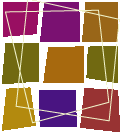STREET GAMES
I was never a big sports fan—I didn’t follow any professional teams and I didn’t play any games beyond what we could collectively imagine we could play in the middle of Tenbroeck Avenue. My Bronx neighborhood was, for the most part, “the block.” That one street bounded by larger avenues on both sides was the center of virtually all recreation activity that touched my life while growing up there in the late 50s and early 60s. The street itself, lined with parked cars on both sides leaving just enough room for two vehicles to navigate in opposite directions down the center, was our playground. We would play right in the middle of the street at any time. Whatever game was in session was always temporarily stopped with the loud cry, CAR!
Some street games involved a ball; most often a soft, pink Spaldeen that someone had recently bought for a quarter up at the candy store. If the game was some sort of ball-bat-base game (the rules were too loose to qualify as baseball) we would usually play “sewer-to-sewer.” Home base was one manhole cover in the middle of the street, and second base was the next manhole cover down—about 50 feet away. First and third bases were the door handles of whatever car was parked closest to the halfway point on either side of the street. And that was our diamond. We didn’t slide, we didn’t wear gloves, and a broomstick was our bat. We just had fun. For some reason, football was not as popular a game on our block. The specialized ball, the physicality of it in the confined narrow strip of asphalt made it an activity saved for a larger, more formal playground. Ours was a tight little street.
Various games would come and go with the changes in season or the changes in fads. For quite awhile we couldn’t get enough badminton! We played with no net, we just stood apart—again sewer-to-sewer—and whacked that poor birdie back and forth. High and low. Slam and lob. Sometimes two against two, sometimes one-on-one. We’d hit the bird so hard that it would occasionally lodge itself in the strings of our cheap racquets. We just pulled it out and kept going. Once in awhile someone would string up an actual badminton net for us to fly the birdie over, but just as often it would be a piece of string or, most likely, nothing at all.
Many games we played in the street involved no equipment at all, like hide and go seek. While it was often called “hide and seek” elsewhere, we phrased it as if it were just two words: HYDINGO SEEK. Just as numerous as the sewer covers were the bright mercury-vapor street lights on every other utility pole. For the youngest among us, the popping on of the streetlights was the signal to go home for the night. For the rest of us, it just meant that our play was extended later into the evening. While it was bright enough to read a book under the harsh yellow lights, no one ever did. Besides, the bright light cast very dark shadows around all the cars parked beneath. Perfect for hiding and and tough for seeking.
We would rollerskate, jump rope, play stoop ball, hit the stick, and bottle cap scully. We would dip and swing yo-yo’s and throw stringed tops. And we would listen for each person’s special call home. We wore no watches. In turn our mothers would call out from the front doors or from open upstairs windows when it was time to come inside. We each knew our own call and our ears pricked up at the sound. And we would take our stuff with us—our ball if we had brought it, our birdies, our yo-yo’s. If some kids remained and suddenly found themselves missing a player, the game was quickly modified on the spot without missing a beat. Or, perhaps, another game to play was decided upon. We ran around and played and played. No swing sets, no play dates, no uniforms. Just the sewer manhole covers to mark our place in the street.

